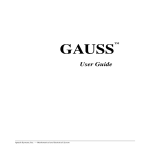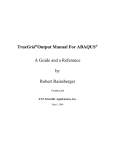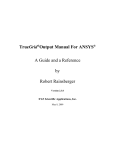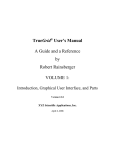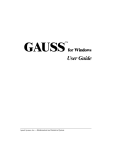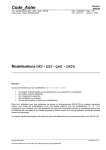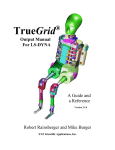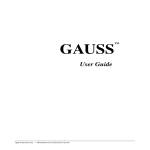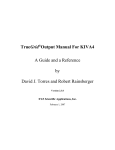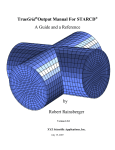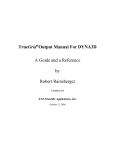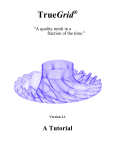Download Parametric Finite Element Modeling Across Many
Transcript
Parametric Finite Element Modeling Across Many Simulation Codes 1 Robert Rainsberger XYZ Scientific Applications, Inc. 1324 Concannon Blvd. Livermore, CA 94550 [email protected] Abstract It is shown, with TrueGrid®, that a finite element model can be created in a preprocessor and exported to many finite element codes such that the model is identical for each finite element code. Parameters, expressions, and conditional statements in a template input file simplify smooth or discrete variations in the generation of the mesh, material properties, element properties, loads, and constraints. Keywords: ABAQUS™; ANSYS®; applied mechanics; computational fluid dynamics; computer models; finite element analysis; finite element modeling; fluid mechanics; hexahedral; LSDYNA™; mathematical modeling; mesh generation; multi-block structured; NASTRAN®; parametric; parametric finite element modeling; projection; quadrilateral; simulation; solid mechanics. Introduction The finite element method (FEM) is an essential tool in the design and understanding of complex structures. A typical finite element session starts with a simplified model to make quick and dirty simulations to gain basic insights into the structure. These insights will lead to refinements in mesh density and detail. This numerical testing of the structure may require numerous simulations with different loads and boundary conditions. There may be significant changes during the evolution of the design of a complex structure. Altogether, many finite element experiments will be required. A preprocessor to the FEM should make it easy to evolve and modify the model. The verification and validation of a finite element computer model places additional requirements on the preprocessor. The identical model must be generated for each code being tested and compared in the verification and validation procedure. Key features of the model need to be isolated so that their properties can be varied independently. This is necessary so that a variance in the measurement of the physical model can be propagated to the numerical model and the results of the simulation. This may also be useful in determining if a linear simulation is stable, meaning a small change in the numerical model should produce small variations in the results of the simulation. Some of the features to vary are material properties, geometric shapes, and mesh density. Ideally, it should be easy to vary these features smoothly or in a discrete manner. It should also be possible to vary features using a random perturbation. A hexahedral 1 Presented at NIST 2004 Workshop on Verification & Validation of Computer Models of Highconsequence Engineering Systems, Nov. 8-9, 2004. mesh for a solid object and a quadrilateral mesh for a shell structure are considered, by many, to be the ideal elements for finite element analysis [2]. This is particularly true for nonlinear analysis. When these types of elements form block structures, the meshes tend to be nearly orthogonal. These types of meshes usually reduce the order of the numerical error in the simulation [9] [10]. Such a mesh is desirable when comparing results from many simulation codes. A poor quality mesh in the simulation will cause confusion when comparing the results of experiments using many simulation codes. On the other hand, a lower quality mesh may be needed to test the range of performance in the simulation codes. Thus it is necessary that a preprocessor have the flexibility to vary the mesh quality. It is also important that small changes to geometry cause only small changes in the mesh density. If a small change in the geometry were to make a radical change in the mesh, then any variation in the simulation results could be the results of the radical change in the mesh. This is a strong argument for multi-block structured meshes where the mesh topology is prescribed. It is potentially a problem with automatic mesh generators that can undergo a radical change in the mesh topology when a small change is made to the geometry. TrueGrid® [1] is a commercial preprocessor for many FEA and CFD simulation codes. It is used to generate high quality, multi-block, linear or quadratic, hexahedral solid, quadrilateral shell or plate, and beam or truss elements. It can also generate prisms, tetrahedrons, and triangles in very small numbers, as required for a good mesh. This paper demonstrates the building and exporting of several simple TrueGrid® models for nonlinear static analysis to be performed by ABAQUS™ [5] [6], ANSYS® [7], LS-DYNA™ [8], and NASTRAN® 2 [4]. Most commands used below to generate these models are not targeted for a particular simulation code because most simulation codes do non-linear static simulations in a similar fashion. Even in a dynamic simulation, the differences in the commands to TrueGrid® for the different simulation codes are quite limited. Each of these simulation codes offers a different set of multi-physics capabilities and, consequently, a different set of loads that can be applied. The different loads will not be discussed in this paper. The remaining differences are categorized as follows: 1. Material models, equation of state, quadrature, and element types - each simulation code has a different set of material types. They all include an isotropic plastic material. Each code defines the yield curve differently. The element type and equation of state are coupled to the material model and are selected at the same time the material properties are selected. Only the hex solid or the quad shell type is selected. If a prism, pyramid, tet, or triangle is formed during the element generation phase, the appropriate element type for that element is automatically selected. The commands that define material properties end with mats. The mate, mt, and mti commands are used to associate a group of elements with a material model. 2 TrueGrid is a Registered Trademark of XYZ Scientific Applications, Inc., ABAQUS is a Trademark of ABAQUS, Inc., ANSYS is a Registered Trademark of SAS IP, Inc., LS-DYNA is a Trademark of Livermore Software Technology Corp., NASTRAN is a Registered Trademark of NASA. 2. Analysis options - initial time step, number of iterations, output and data base options, solution method, case selection, and other global controls fall in this category. The commands that specify the analysis options end with opts. 3. Element cross sectional properties - shell cross sectional properties are defined within the material model definition. Variable shell thicknesses are not supported by all simulation codes and must be avoided when making validation and verification comparisons. Beam cross section properties vary greatly and are defined with the bsd command. These beam cross sectional properties are then referenced within the material definition or the commands that generate the beams such as ibm, jbm, kbm, and bm. A limited orthotropy feature is handled within the material model. It is this author’s wish that beam cross section properties be standardized. The benefits would include translation of the model from one simulation code format to another and verification and validation of finite element models. With a standard in beam cross sections, one could have greater confidence in the comparison of results from many simulation codes. Perhaps the beam cross sectional properties defined in the IGES [3] standard can be used as a standard. If each simulation code supported at least these features, then translations and comparisons could be assured. 4. Contact surfaces - methods used in the simulation codes vary greatly and continue to evolve. The sid command is used to select the properties of the contact surfaces. This author is not aware of any comparative studies of the contact surfaces available in these simulation codes. An advanced verification and validation of finite element computer modeling should include contact surfaces. One common characteristic of contact surfaces is a loss of accuracy. In particular, tied contacts used to glue two dissimilar faces of a material interface are unwarranted in TrueGrid®. The interface between two parts of the mesh can always be made to match. The block boundary (bb) command is used to glue two similar parts. The transitional block boundary (trbb) command Example of a transition region between two blocks will glue two dissimilar faces together using all hex elements for solids and all quad elements when using shells by automatically generating a transitional region at the interface. There are some limitations to the trbb command that are easily met when the mesh topology is planned. 5. Springs, dampers, and point masses - material properties and degrees of freedom vary between the simulation codes. If a model is to be run with these special element types, properties should be selected that are available in all simulation codes. The spd command specifies the material properties. The degrees of freedom are specified when the element is defined with, for example, the spring command. Point mass properties are defined at the time these elements are generated with, for example, the pm and npm commands. In the examples below, text in the Courier font indicate input to TrueGrid®. Bold Courier font indicates a keyword command. The c command starts a comment. TrueGrid® accepts a batch file or runs interactively with menus and buttons. A session file is generated to record both batch and interactively generated commands. This session file can be used to reproduce the model in batch mode. Typically, the user creates a simple model interactively and then modifies the session file with a text editor for subsequent reruns in batch mode. The interrupt and resume commands can be useful when making incremental changes, interactively, to the batch file. Creating a Single Block Part The block command creates a three dimensional rectangular mesh. The numbering of nodes in each of the three directions is independent, starting with 1. This produces a three dimensional array of nodes. Each node is uniquely identified by three indices. They are referred to as the i, j, and k indices. For example, the command block 1 5; 1 6; 1 7; c c c c indices of a single block part i-list j-list k-list produces a grid with an i-index ranging from 1 to 5, a j-index ranging from1 to 6, and a k-index ranging from 1 to 7. Each pair of numbers in the block command ends with a semi-colon and is referred to as an index list. The semi-colon terminates each list. It is shown, in the next example, that the block command can be used to create a part with many blocks. For this reason, the syntax for the block command must allow for each index list to have arbitrary length. The three dimensional space containing the i, j, and k indices is sometimes referred to as the computational domain of the mesh. The edges of this block are initially parallel to the coordinate axis and the faces are planar. The remaining arguments of the block command assign x, y, and z-coordinates to the mesh. For example, 2 5; 1.4 7; 2 7; c x-coordinate list c y-coordinate list c z-coordinate list completes the block command above. The first list of coordinates specifies the x-coordinate for the 2 faces perpendicular to the x-axis. There must be one x-coordinate for each index in the iindex list. The same is required for the y-coordinates corresponding to the j-index list and the zcoordinates corresponding to the k-index list. Sometimes the three dimensional space containing the x, y, and z-coordinates is referred to as the physical range of the mesh. Creating a Multi-Block Part The block command is generalized so that a single part can have any number of connected blocks. The block command usually contains more blocks than are needed for a particular problem. This is because it is usually easier to define an array of blocks and delete some of them then it is to define each required block separately. For example, para th .1; block 1 13 17 31 35 47; 1 5 10 14; 1 25; 0 .28 .37 .63 .72 1; 0 .08 [.08+%th] [.16+%th]; 0 .5; c sample thickness parameter c c c c c c i-index list j-index list k-index list x-coordinate list y-coordinate list z-coordinate list This part has 5 blocks in the i-direction, 3 blocks in the j-direction, and 1 block in the k-direction in the computational domain. Each number in the i-index list specifies the end of one block and the beginning of the next. The same is true about the j-index and k-index lists. The interfaces between the blocks, located at the node numbers in the index lists, are referred to as partitions and they are numbered by their sequence in the index list. The x, y, and z-coordinate lists position the partitions in the i-, j-, and k-directions, respectively. A few more commands will be introduced and added to this block command to build a simple model of a sample material being drawn between two clamps. Physical Mesh with 13 blocks of hex elements Computation Mesh with 13 blocks Starting with the block command above, all unneeded blocks are removed with a dei (delete) command. For example, the command dei 3 4; 1 2 0 3 4;1 2; c delete 2 blocks removes two blocks. Both blocks start at the 3rd partition and end in the 4th partition in the idirection. One block goes from the 1st to the 2nd partition in the j-direction. The second block goes from the 3rd to the 4th partition in the j-direction. Note that the 0 in the j-index list is used to indicate a gap and can be interpreted as the word “and”. Both blocks go from the 1st to the 2nd partition in the k-direction. Commands that end with i require three index lists. The three index lists are sometimes referred to as an index progression. De is an alternative form of the delete command. This command deletes one block. The following accomplishes the same thing as the above dei command: de 3 1 1 4 2 2 de 3 3 1 4 4 2 c delete first block c delete second block This type of command requires 6 numbers. They are: starting i-partition number starting j-partition number starting k-partition number ending i-partition number ending j-partition number ending k-partition number These six numbers are sometimes referred to as a region. The region notation is an option because of its simplicity. With large and complex models, this notation becomes tedious and inefficient. Typically, a beginner chooses commands with a region notation and graduates to commands with an index progression as they become sophisticated users. Large and complex structures can be constructed using index progressions with a minimum number of commands. The graphical user interface and, in particular, the computational window makes the selection of an index progression relatively intuitive. Parametric Nature of the Block Command The block command is one of only two commands that specify the block structure or topology of the part. The insprt command, to insert a partition, is the other command but is not detailed in this paper. The block command is one of only two commands that specify the number of nodes within each block of the part. The other is the mseq command that adds or removes nodes. The insprt and mseq commands augment the block command so that the user can change the mesh without having to go back and modify the block command. The mseq command is also not discussed in further detail because it is available only as a convenience and does not offer a fundamental capability. If we ignore these two exceptional commands, the block command is the only command that refers to the actual nodes in the mesh. All subsequent commands in the part refer to partition numbers. Essentially, the numbers in the index progression and the region notation are numbered parameters whose true values are specified in the block command. Thus the user can change the number of nodes in the mesh by modifying the index lists in the block command. All other commands will be automatically adjusted. Moving Corners of the Mesh Portions of the mesh, either a region or an index progression, can be moved as a rigid body using the pb, mb, and mbi commands. The pb command assigns coordinates and the mb or mbi commands modify the coordinates by adding a component. For example, pb 3 1 1 4 1 2 y .08 mb 3 4 1 4 4 2 y -.08 c assign the y-coordinate c decrease the y-coordinate Final mesh after moving 8 corners The tr command is a more general method of manipulating the mesh. These three commands change the coordinates of the corners of the blocks. Then the edges, faces, and interior nodes are interpolated. The graphical user interface can be used to create these commands with a click and drag of the mouse to move the corners of the block. The arguments to these commands can then be replaced with parametric algebraic expressions using a text editor to modify the session file. Nodal Constraints The b and bi commands assign nodal constraints. In the command below, the z-displacement is constrained at the base of the clamps. For some simulation codes with case control, such as ABAQUS™ and NASTRAN®, a set identifier or case control number (sid) should be assigned to the constraint. Notice that this command ends in a semicolon indicating this command has many options. Any of the degrees of freedom can be constrained by adding options to the list. bi 1 3 0 4 6;1 2 0 3 4;-1;sid 1 dz 1 ; Fixed Displacement For historical reasons, many commands imposing loads require a load curve number, set identified, or case control number. For example, the fd and fdi specify fixed displacements. This identification number in the argument list is followed by an amplitude and a 3D displacement vector. fdi -1;1 2 0 3 4;1 2;1 1 -1 0 0 fdi -6;1 2 0 3 4;1 2;1 1 1 0 0 Material Assignment Materials are identified with a positive number. The properties of the material are defined below. All elements are assigned a material number. The default is 1. The mate command changes the default. The mt and mti commands assign materials to different regions of the mesh. In the draw model, the elements to be drawn are assigned material 1 and the clamp elements are assigned material 2 by default. mate 2 mt 1 2 1 6 3 2 1 Other Parametric Features The para command defines parameters that can be used in place of any number. The % character must precede the use of any parameter. para k2 7 density 2.236 ; c define k2 and density Algebraic expressions can be inserted wherever a number is needed to complete a command. The expression must be enclosed by the open and close square brackets. The syntax for operators and intrinsic functions match FORTRAN with the following exceptions: 1. ^ and ** can be used for exponentiation 2. Trigonometric functions use degrees (not radians) 3. The norm function generates a random variable with a normal distribution para k2 [3**2+1] density [sqrt(5)]; c define k2 and density The intrinsic functions are int, nint, abs, mod, sign, max, min, sqrt, exp, log, log10, sin, cos, tan, asin, acos, atan, atan2, sinh, cosh, rand, and norm. Additional functions can be defined with the def command. def function_name(a,b,c) = expression The function can have many dummy arguments. The expression should be dependent on the dummy arguments. Once defined, a function can be used in the same manner as the intrinsic functions. The if, elseif, else, endif conditional statement is also available with the same properties as in FORTRAN. For example: if(%density.gt.1.0)then block 1 5;1 6;1 %k2;2 5;1.4 7;2 7; else block 1 5;1 6;1 [%k2*%density];2 5;1.4 7;2 7; endif The above commands issue a different block command depending on the density parameter. A typical use of the conditional statement is to insert a new partition when the conditions warrant it. For example: if(%rad3-%rad1.gt.0.1)then if(%i3-%i1.lt.6)then mseq i [6+%i1-%i3] c add elements in the i-direction endif insprt 1 2 1 5 c insert a partition in the i-direction endif The include command will transfer the input stream to another file. After all the commands are read from this file, the input stream is then returned to the original source. If the file is parametric, then the include feature is similar to a subroutine call in a programming language. For example: c c c c c rad is the radius of the x0 is the x-component of y0 is the y-component of z0 is the z-component of n is the node density of sphere the center of the sphere the center of the sphere the center of the sphere the mesh para rad 1.0 x0 0 y0 0 z0 0 n 10; c set parameters for sphere 1 include sphere c include the spherical part file para rad 1.2 x0 2 y0 2 z0 2 n 12; c set parameters for sphere 2 include sphere c include the spherical part file produces two spheres using the commands in an included file called sphere. The details of the sphere file are left to the reader. Code Specific Material Models and Analysis Options Another important use of the if, elseif, else, and endif statements are now shown with the material models for all the simulation codes mentioned above. The outtyp parameter will be used to set the output format type so that only this parameter needs to be changed to switch from one output option to any other. We adopt the following convention for the value of outtyp: c 1 means c 2 means c 3 means c 4 means para output output output output outtyp to to to to 1; ABAQUS ANSYS LS-DYNA NASTRAN In this example we will use the following material parameters including some isotropic plasticity constants to define the same material model for all four simulation codes: para rho 7.0e-4 e 3.0e+7 pr .3 sigy 75000 et 1.0e+5; c c c c c density Young’s Modulus Poisson’s Ratio yield stress tangent modulus There will actually be two material models. The first is for the material that will be deformed. The second material will be used for the hardened metal clamps. Similar features are selected for each simulation code. It is convenient to lump all of the code specific analysis options with the code specific material commands. para ts .01 term .1; c time step c termination time The material models and analysis options in each simulation code are quite different. Therefore, the syntax of the commands to specify these properties in TrueGrid® is different for each simulation code. With the aid of the graphical user interface, it is easy to create the same material model for all four simulation codes. The graphical user interface produces the correct syntax that is then recorded in the session file. There is a pattern to these commands. A command is needed to select the output format. It is usually the name of the simulation code. The commands are: abaqus, ansys, lsdyna keyword, and nastran. The lsdyna command has an argument because older versions of LS-DYNA™ allowed for a second format that is still available in TrueGrid®. The analysis commands are abaqstep, ansyopts, lsdyopts, and nastopts. The ABAQUS™ analysis options command is different because it is needed for each step. The other simulation codes option commands are usually issued only once. The material commands are abaqmats, ansymats, lsdymats, and nastmats. Each use of these commands defines one material. Both the analysis options and the material definitions can have many options activated and each command is terminated with a semicolon. After the commands to choose the output, material models, and analysis options have been issued, the if, elseif, endif statements, the parameters, and comments can be added to the session file with a text editor to produce: if(%outtyp.eq.1)then c ABAQUS specific abaqus c selects the output format abaqstep abstep 1 c STEP definition static .0001 %ts %term ; c select static analysis abcload blc 1 fd ; c include displacements load curve 1 abaqmats 1 c elastic-plastic material aqeltyp C3D aqdens %rho aqelas aqelis %e %pr ;; aqplas %sigy [%sigy/%e]; [%sigy+(1-%sigy/%e)*%et] 1;;; abaqmats 2 c same as first material but stiffer aqeltyp C3D aqdens %rho aqelas aqelis [10*%e] %pr ;; aqplas [100*%sigy] [100*%sigy/%e]; [100*%sigy+(1-10*%sigy/%e)*%et] 1;;; elseif(%outtyp.eq.2)then c ANSYS specific ansys c selects the output format ansyopts antype 0 c static analysis eqslv sparse 1.0e-8 c solution method autots on c automatic time step andtime %ts c time step size antime %term ;; c termination time ansymats 1 stif185 c plastic solid element prxy %pr; ex %e; dens %rho; biso %sigy %et ;; c Bi-linear isotropic ansymats 2 stif185 c same as the first but stiffer prxy %pr; ex [10*%e]; dens %rho; biso [100*%sigy] %et ;; elseif(%outtyp.eq.3)then c LS-DYNA specific lsdyna keyword c selects the output format lsdyopts c analysis options iautf 1 c automatically adjust time steps imflag 1 c implicit dt0 %ts c initial time step nsolvr 2 c BFGS updates implicit solver endtim %term c termination time d3plot dtcycl .01 ; ; c output interval lsdymats 1 24 c rate-dependent isotropic plastic brick elfob csb c element type and formulation rho %rho e %e pr %pr sigy %sigy et %et; lsdymats 2 24 brick elfob csb c same as the first but stiffer rho %rho e [10*%e] pr %pr sigy [100*%sigy] et %et; elseif(%outtyp.eq.4)then c NASTRAN specific nastran c selects the output format nastopts sol 106 c type of solution nlparm 1 [%term/%ts] c ID and number of increments auto ; c automatic stiffness updates nastmats 1 1 c isotropic elastic-plastic e %e nu %pr rho %rho psolid plastic c element type with plasticity hslope %et yldfun 1 inyldp %sigy ; nastmats 2 1 c same as the first but stiffer e [10*%e] nu %pr rho %rho psolid plastic hslope %et yldfun 1 inyldp [100*%sigy] ; endif The ABAQUS™ element type is implied from the material options selected from the menus. The ANSYS® element type is selected first which then dictates the available material options. The LS-DYNA™ material type is selected first which dictates which options and element types are available. LS-DYNA™’s notion of a part is the same as a material in TrueGrid®. In contrast, a part in TrueGrid® can consist of many different materials by using the mate, mt, and mti commands. For NASTRAN® output, the linear material is selected first. Then the element type and non-linear properties are added. I-beam With Hole Using Shell Elements This next example demonstrates the use of curves and replications to create a shell model of an I-beam with holes. The block command is used to define a block structured quad shell mesh. It has the same syntax as above using index lists to form multiple blocks in all three directions, with one exception. A minus sign is used to identify the indices in these lists that correspond to shell faces in the mesh. para r .65 thw .2 thp .25; c radius c web thickness c plate thickness block 1 7 13 19; 1 -7 13; -1 7 13 -19; 0 [1.5-%r*sin(45)] [1.5+%r*sin(45)] 3; -1 0 1; 0 [1.5-%r*sin(45)] [1.5+%r*sin(45)] 3; c c c c c c c shell part i-list j-list k-list x-list y-list z-list The second partition in the j-list is a shell face that forms the web of the I-beam. The first and last indices in the k-list form the bottom and top plates of the I-beam. One block in the middle of the web of the I-beam is deleted. The four edges to this hole will be deformed to the shape of a circle. dei 2 3; -2; 2 3; Shell I-Beam part with holes The th and thi commands assign shell thicknesses. The last argument to these commands is the thickness. thi ; ;-1 0 -4;%thp th 1 2 1 4 2 4 %thw Attaching to a 3D Curve A circle is needed to shape 4 edges of the mesh. The curd (CURve Definition) command has many 3D curve types and is used in this case to define the circle. This example also shows how parameters can be used to form geometry. The first argument to the curd command is the curve identification number followed by the curve type and related arguments. curd 1 arc3 c define a circle by 3 points whole rt [1.5-%r] 0 1.5 rt 1.5 0 [1.5-%r] rt [1.5+%r] 0 1.5 ; The curs command attaches an edge of the mesh to a curve. The curs command requires a region (see the definition of a region above) followed by the curve number. The order of commands for a part does not matter. The commands are ordered within TrueGrid® so that all of the move commands, such as pb, mb, mbi, and tr, are used first. Then the commands to attach edges to curves are used. The end nodes of the edge (i.e. corners of the block mesh) can be moved with the mouse to control the way an edge is attached to a curve. Since the order in which commands are issued does not matter, one can attach an edge to a curve and then, interactively, move the corners of the mesh into position. For this simple example, no move commands were needed because the coordinates in the block command were carefully chosen. curs curs curs curs 2 3 2 2 2 2 2 2 3 2 2 2 3 3 3 2 2 2 2 2 3 3 2 3 1 1 1 1 Part Replication Two commands are needed to replicate a part. The lct command defines the transformations to be applied to each copy of the part. Then the lrep command identifies which transformations are to be used. The 0 transformation is the identity transformation (i.e. no transformation is applied to a copy of the part). lct 3 mx 3;repe 3; lrep 0:3; I-Beam With Hole Using Brick Elements A solid mesh of the same model requires two partitions for each of the web, the bottom plate, and the top plate. This example shows the creation of a surface and the projection of the edges of the hole to that surface. Projection to surfaces is preferred over attachment to curves, because projection is a constrained Newton method that automatically calculates the intersection of surfaces, wherever it is required. As was mentioned above, the order that commands are issued is not important. The TrueGrid® algorithm sorts the commands and uses them in the following order: 1. move corners to points 2. attachment edges to curves 3. projection faces to surfaces The results of moves and attachments to curves are used to determine the points of projections on the surfaces. This internal ordering of commands is referred to as the command hierarchy in TrueGrid®. The sd (Surface Definition) command is followed by a surface identification number, a surface type, and associated arguments. In the definition below, surface 1 is defined as a cylinder. The axis of rotation is parallel to the y-axis and passes through the point (1.5,0,1.5). This cylinder has a radius %r. sd 1 cy 1.5 0 1.5 0 1 0 %r c surface 1 block 1 7 13 19; 1 7 9 15; 1 3 9 15 21 23; 0 [1.5-%r*sin(45)] [1.5+%r*sin(45)] 3; -1 [-%thw/2] [%thw/2] 1; [-%thp] 0 [1.5-%r*sin(45)] [1.5+%r*sin(45)] 3 [3+%thp]; dei 1 4; 1 2 0 3 4; 2 5; dei 2 3; 2 3; 3 4; Brick I-Beam part with a hole The sf and sfi (project to SurFace) commands constrain parts of the mesh to a single surface. If an edge or a corner node is required along the intersection of several surfaces, then these commands need to be issued at least once for each surface. In this example, the four faces of the hole are projected to surface 1. sfi -2 -3; -2 -3; 3 4;sd 1 Creating the FEM File The final step in the process is to assemble the mesh and write the output file for the appropriate simulation code. Four commands are needed. merge c enter the assembly phase stp .0001 c merge the coincident nodes write c write the output file quit Summary Simple examples have been used to demonstrate features in TrueGrid® that can be of great value to verification & validation of virtual prototyping. Those features are: 1. output formats for many simulation codes 2. batch mode so that a template FEM can be easily modified 3. material models and analysis options that only need to be defined once 4. parameters and expressions used wherever they are needed 5. high quality elements to minimize the effect of the mesh on the results 6. smooth and predictable variations in the mesh 7. loads and constraints The TrueGrid® User’s Manual and Examples Manual, in electronic form, are available. Emailing requests to [email protected]. Input decks to the draw, shell I-beam, and solid I-beam are also available upon request. As a final note, TrueGrid® supports many options for ABAQUS™, ANSYS®, LS-DYNA™, and NASTRAN®. However, these simulation codes are constantly improving and TrueGrid® does not support every feature in every code. If TrueGrid® does not support a feature, try two things. First contact the support team at XYZ Scientific Applications at (925) 373-0628 and ask if this feature can be added to TrueGrid®. Also try the verbatim command. verbatim multi-line block of text endverbatim This command will take any text within its scope and duplicate it, verbatim, in the output file. References 1. TrueGrid® Manual, version 2.1.0, by XYZ Scientific Applications, Inc., Sept. 7, 2001. 2. Benzley, S.E., Perry, E., Merkley, K., Clark, B., and Sjaardama, “A Comparison of All Hexagonal and All Tetrahedral Finite Element Meshes for Elastic and Elasto-Plastic Analysis”, Proceedings, 4th International Meshing Roundtable, Sandia National Laboratories, pp. 179-191, October 1995. 3. National Computer Graphics Association, " The Initial Graphics Exchange Specification (IGES), Version 5.1", IGES/PDES Organization, Fairfax, Va. (1991). 4. MSC/NASTRAN, "User's Guide", The MacNeal-Schwendler Corporation. Los Angeles, Ca. (1994). 5. ABAQUS™ Version 6.4 PDF Documentation, "User's Manual" ABAQUS, Inc. Pawtucket, RI. (2003). 6. ABAQUS™ Version 6.4 PDF Documentation, "Reference Manual" ABAQUS, Inc. Pawtucket, RI. (2003). 7. Ansys®, Inc., "Ansys 6.1 Documentation", SAS IP, Inc., Canonsburg, Pa. (2002). 8. "LS-DYNA Keyword User's Manual Version 970", Livermore Software Technology Corp., Livermore, Ca. (1992-2002). 9. J. F. Thompson, Z. U. Z. Warsi and C. W. Mastin, Numerical Grid Generation, North-Holland, NY (1985). 10. J. F. Thompson, B. K. Soni, N. P. Weatherill, Handbook of Grid Generation, Chapter 32, “Truncation Error on Structured Grids” by C. W. Mastin, pp. 32-1 to 32-10, CRC Press, NY (1999). Appendix - Commonly Used TrueGrid® Commands The following is a list of the most commonly used commands in TrueGrid®. The name of the submenu for a command is found in the parentheses next to the key word command. Some of the commands have an optional i suffix for the index progression form of the command. Parts block - (parts) initiate a multi-BLOCK part in Cartesian coordinates cylinder - (parts) initiate a multi-block part in CYLINDRical coordinates cycorsy - (parts) Cylindrical Coordinate System frame of reference insprt - (mesh) INSert a partition in the block part topology mseq - (mesh) change the number of elements in one direction of the block part de(i) - (mesh) DElete blocks Move Corners pb - (mesh) Placement mb(i) - (mesh) relative Move (by Index progression) tr(i) - (mesh) generalize TRansformation (by Index progression) Attach to One 3D Curve curs - (mesh) attach edgeS of the mesh to a CURve curd - (3D curves) CURve Definition Project to One Surface sf(i) - (mesh) project faces to a SurFace (by Index progression) sd - (surfaces) Surface Definition Gluing bb - (interface) Block Boundary definition and assignment trbb - (interface) TRansitional Block Boundary definition and assignment Smoothing unifm(i) - (mesh) UNIForM relaxation of solids (by Index progression) tf(i) - (mesh) invoke TransFinite interpolation (by Index progression) Input/Output iges - (cad) extract all entities from an IGES file readmesh - (parts) READ a file containing a MESH abaqus - (output) ABAQUS™ output format ansys - (output) ANSYS® output format lsdyna keyword - (output) LS-DYNA™ output format nastran - (output) NASTRAN® output format write - (output) WRITE the output file postscript - (graphics) direct output to a POSTSCRIPT file Materials abaqmats - (materials) ABAQus MATerialS ansymats - (materials) ANSYs MATerialS lsdymats - (materials) LS-DYna MATerialS nastmats - (materials) NASTran MATerialS mt(i) - (material) assign a material number to a set of elements (by Index progression) mate - (material) set the default material number Analysis Options abaqstep - (analysis) ABAQus STEP for analysis ansyopts - (analysis) ANSYs OPTionS lsdyopts - (analysis) LS-DYna OPTionS nastopts - (analysis) NASTran OPTionS Merging stp - (merging) Surface Tolerance with Printout Load Curve lcd - (2D curve) Load Curve Definition Beams and Shells ibm(i) - (element) I-direction BeaMs (by Index progression) jbm(i) - (element) J-direction BeaMs (by Index progression) kbm(i) - (element) K-direction BeaMs (by Index progression) bm - (element) BeaMs along a 3D curve bsd - (element) Beam cross Section Definition th(i) - (element) shell THickness (by Index progression) Mesh Quality measure - (diagnostic) MEASURE mesh quality elm - (diagnostic) display ELements within a given range of Measure labels - (graphics) display LABELS for objects in the picture condition - (graphics) use tokens to display various boundary CONDITIONs mlabs - (graphics) display Multiple LABels and conditionS for objects in the picture Viewing slice - (graphics) SLICE the picture by removing everything beyond a plane Sets nset(i) - (sets) modify a Node SET (by Index progression) fset(i) - (sets) modify a Face SET (by Index progression) eset(i) - (sets) modify a Element SET (by Index progression) Loads and Constraints b(i) - (boundary) nodal constraints or Boundary conditions (by Index progression) fd(i) - (dis/vel/acc) Fixed Displacement (by Index progression) fc(i) - (force) ForCe (by Index progression) Misc. para - (misc) define some PARAmeters interrupt - (misc) INTERRUPT the batch file with interactively generated commands resume - (misc) RESUME the batch file after being interrupted help - provide HELP dialogue for the given command if-then-else - (misc) conditional statements include - (misc) INCLUDE commands from a file def - (misc) DEFine an inline function Replication lct - (replicate) define a list of Local Coordinate Transformations lrep - (replicate) Local REPlications of a part using transformations from lct above




















